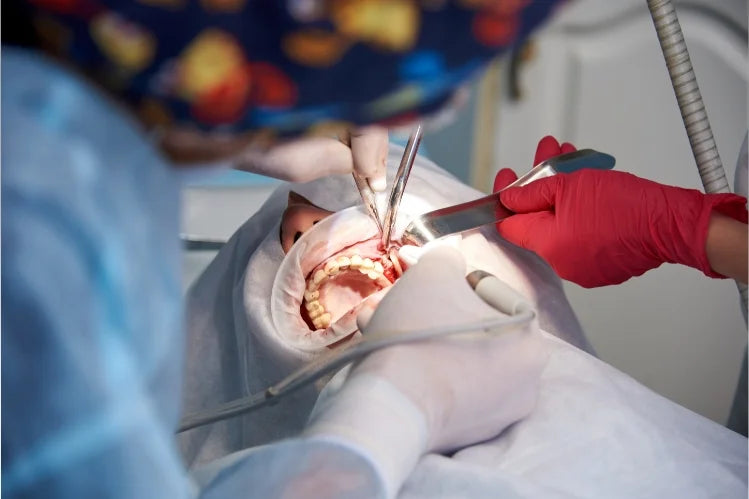
Table of contents
-
Understanding Teeth Straightening Surgery
-
Why is There a Need For Teeth Straightening Surgery?
-
What are Some Options For Teeth Straightening Surgery?
-
The Process of Teeth Straightening Surgery
-
Benefits Offered By This Method
-
What are Some Limitations of Teeth Straightening Surgery?
-
What are Some Surgical Alternatives?
-
What is Teeth Straightening Surgery Cost?
-
Treat Your Smile With Smilepath
-
FAQs
Do you have a misaligned smile? And are you thinking of straightening it through a teeth straightening surgery? If the answer is yes, then this blog is for you.
Teeth straightening surgery has been considered a great option for those going through severe dental issues. It is a helpful procedure that offers multiple benefits but also comes with its own set of considerations. In this blog, we will get to understand the teeth straightening process, its advantages, and its limitations.
Understanding Teeth Straightening Surgery
Teeth straightening surgery is a dental procedure that is carried out to align asymmetrical smiles. It is mostly done for severe malocclusions and is treated by repositioning jawbones. Other than treating the position of teeth, it also helps in improving bite or chewing issues.

The severity of the following dental conditions is usually treated by teeth straightening surgery:
-
Underbite or Overbite
A condition in which the upper or lower jaw overlaps the other causing a misalignment of smile.
-
Crossbite
When upper teeth fit inside the lower teeth, the condition is referred to as crossbite
-
Crowding
If the patient’s jaw is unable to accommodate all the teeth, they overlap each other leading to a crowded smile.
Why is There a Need For Teeth Straightening Surgery?
Teeth straightening surgery is made compulsory for people with the following conditions:
-
Long-Term Dental Issues
Severe malocclusions are the main reason for a person to undergo a teeth straightening surgery. Long-term dental issues can harm the overall health of your mouth leading to bite and chewing problems, hence surgical teeth straightening can help you overcome such problems.
-
Facial Asymmetry
A misaligned jaw leads to an asymmetrical structure of your face causing a lack of confidence. A surgical process straightens your teeth, aligns your jaw, and improves the overall appearance of the face.
What are Some Options For Teeth Straightening Surgery?
If you are considering going through a teeth straightening surgery, the following are some options depending on the dental condition:
-
Orthognathic Surgery
The teeth straightening surgery is also known as orthognathic surgery. It is done to reposition the jaw and improve the bite and chewing issues. It takes multiple steps to prepare your jaw to undergo a surgical process.
To begin the surgery, your doctor may require the following pieces of information:
1. Dental X rays
2. CT Scans
3. Smile impressions
4. Photographs of your smile
-
Dental Implants
If a patient has a missing tooth, it can be treated by dental implants. Since gaps in teeth can lead to bleeding gums and infections dental implant surgeries play a crucial role in maintaining your smile.
-
Veneers
These are the dental products placed on your teeth to enhance the aesthetics of your smile. Veneers are used for dental conditions such as chipped teeth or stains compromising your perfect smile. Dental veneers are implanted by removing the enamel layer from the surface of the teeth to make it rough. This helps the veneer stay on the teeth enhancing the look of your smile.
The Process of Teeth Straightening Surgery

The following are the steps involved in surgical teeth straightening treatment:
-
Initial Examination
Your dentist will examine your dental condition before suggesting a teeth straightening method. Surgeries are only recommended for severe conditions that are not treated in other ways.
-
Treatment Plan
A treatment plan is generated for you which highlights the results you are going to achieve. The plan also outlines the specific adjustments your smile needs.
-
Surgery
Since the surgery can be a painful procedure, it is performed under anesthesia. This also helps in providing comfort to the patient and prevents any inconvenience during the process.
-
Recovery period
After the surgery, the jaw and teeth are in the healing process which is why the patients are required to stay in the hospital for a few days. The recovery period for teeth straightening surgery is around six weeks.
-
Precautionary Measures
Even after the surgery, you are required to get your dental checkups to avoid any complications. Visit your dentists for follow-ups and help your jaw recover from the surgery.
Benefits Offered By This Method
The following are some benefits of teeth straightening:
-
Enhanced Aesthetics
Once your jaw is positioned in the right place, it improves overall facial structure. Hence it benefits a person by providing enhanced aesthetics.
-
Improved Speech
A misaligned smile or jaw prevents the proper pronunciation of some words. When your smile is aligned it improves your speech and leads to enhanced confidence.
-
Better Chewing
A dislocated jaw or asymmetrical teeth pattern prevents proper biting and chewing of food. Going through a surgical teeth straightening procedure improves your bite and creates ease for you in chewing.
What are Some Limitations of Teeth Straightening Surgery?
No doubt teeth straightening surgery offers multiple benefits but it comes with some limitations that are mentioned below:
-
Surgical Risks
This treatment is done for severe dental conditions and has multiple risks associated with it. Before deciding to undergo a surgical process, consult for an expert’s advice. Orthodontic surgeries involve the risk of severe bleeding, a reaction against anesthesia, and swellings. This is why your doctors keep you under observation post-surgery to monitor if there are any issues.
-
Delayed Recovery
After going through dental surgery to treat your smile, the healing process varies on a person’s condition. Hence the recovery period might get extended. To stay on the safe side, make sure you intake soft diet and maintain your oral hygiene.
-
Not a Quick Treatment
Opting for a surgical process does not help provide quick results but it involves multiple steps. For instance, a patient goes through pre-surgical care before going through the procedure, and later post-care is also made mandatory. Teeth straightening surgery demands a lot of time and patience before you finally head towards healing.
What are Some Surgical Alternatives?
If your doctor does not recommend a teeth straightening surgery which means you can opt for other ways as well. The advancement in the orthodontic world has introduced multiple ways through which your dream smile can be achieved. The following are the two main surgical alternatives that can help you out:
Metal Braces

Metal braces treatment is a traditional teeth straightening method carried out with the help of metal brackets and wires attached to your teeth. This treatment requires frequent dental visits to tighten the braces which helps in repositioning the teeth. Furthermore, since these are attached to your teeth they prevent proper cleaning and lead to dental plaques further aggravating the dental problems.
Clear Aligners

This is an alternative treatment for metal braces. These are customized dental trays that are placed on your smile. They work by gradually shifting your misaligned teeth to the desired position and lead to better appearance.
Each set of clear aligners is worn for 20 to 22 hours per day. The dental trays are easily removable and do not require dentist visits. Hence the treatment is user-friendly and can be carried out at home.
What is Teeth Straightening Surgery Cost?
The teeth straightening surgery can cost more than the alternative procedures due to several reasons such as the severity of the dental problem being treated. According to research, the cost varies on the complexity of the condition and operator-dependent factors.
The following is the estimated cost of the non-surgical dental treatments along with their pros and cons:
| Treatment | Cost Range | Pros | Cons |
|---|---|---|---|
| Metal Braces | $3000-$7000 | Can be used for mild, moderate, or severe conditions | Visible, painful, and discomforting |
| In Office Clear Aligners | $3000-$8000 | Removable and invisible | Requires dental visits |
| At Home Clear Aligners | $1,000 - $3,000 | Comfortable, convenient, and affordable | Less supervision and only suitable for mild to moderate conditions. |
Treat Your Smile With Smilepath
If you are looking for a brand that offers convenient and comfortable non-surgical teeth straightening procedures, Smilepath can help you out. You can get your customized clear aligners in three simple steps:
- Use our at-home impression kit to create your dental impressions and mail them back to us.
- Approve your 3D treatment plan showing you exactly how your smile will look post-treatment.
- Receive your aligners and wear them according to the given instructions to improve your smile without ever going through major dental surgery.
To sum it up, teeth straightening surgery also known as orthognathic surgery can be a helpful way for many patients. It offers multiple benefits such as enhanced confidence and bite correction but has different limitations as well. If you are thinking of undergoing a teeth straightening surgery make sure to consult your dentists. Mild to moderate dental conditions can be treated by metal braces or clear aligners hence opt for a surgical procedure only if you have a severe condition.
FAQs
It is a teeth straightening surgery that works by repositioning your jaws and treating your smile. It further leads to enhanced facial structure and bite correction.
When your smile is misaligned it gives rise to poor dental health. If the condition gets severe it impacts chewing, speaking, and oral hygiene. To treat all these conditions a teeth straightening surgery is done.
The teeth straightening surgery aims to improve the smile, correcting misalignments and enhancing the aesthetics of your smile.
Yes! Metal braces, clear aligners, and retainers are some alternatives for teeth straightening surgical procedures helpful for mild to moderate dental conditions.
There are two types of orthognathic surgeries; lower jaw orthognathic surgery and upper jaw orthognathic surgery.
Related Blogs
https://smilepath.com.au/blogs/blog/straighten-your-overlapping-teeth-today
https://smilepath.com.au/blogs/blog/transform-your-smile-with-clear-aligners-for-teens
https://smilepath.com.au/blogs/blog/clear-aligners-modern-way-to-straight-teeth




 Australia
Australia New Zealand
New Zealand Malaysia
Malaysia English
English Portuguese
Portuguese English
English English
English English
English English
English English
English Canada
Canada